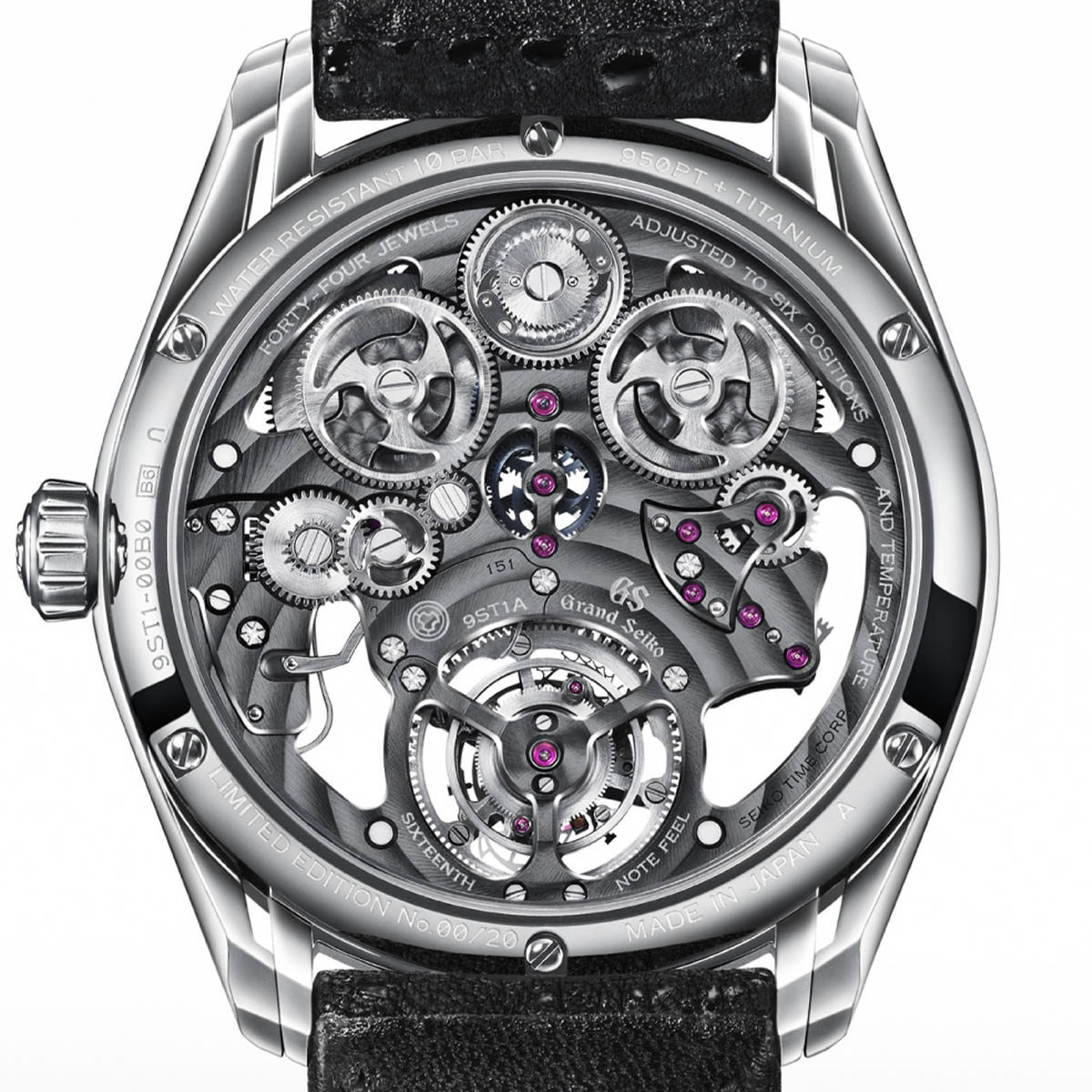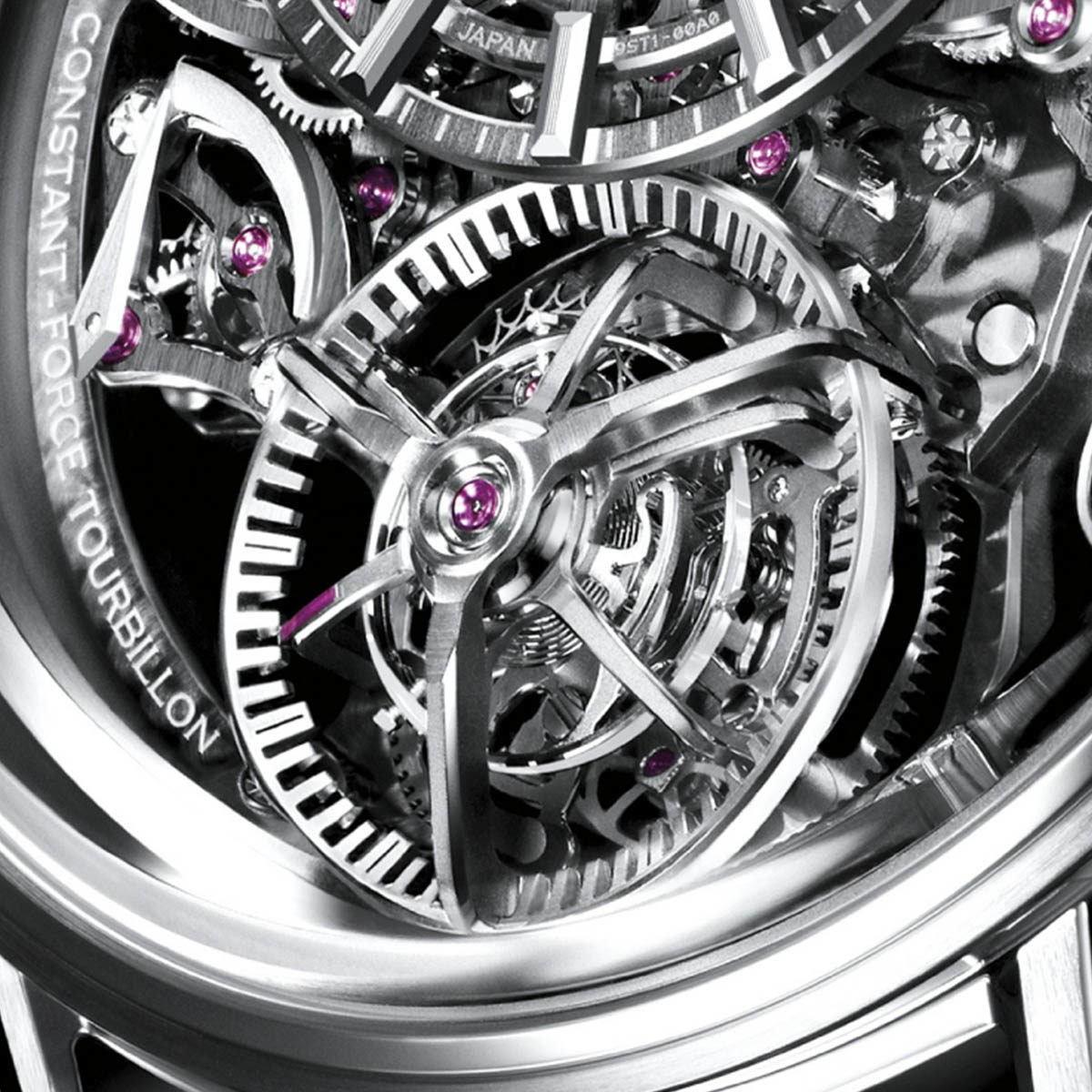Every now and then, a watchmaker will release something entirely unexpected. Something so far from what we might have anticipated, it leaves the watch-collecting community with slack jaws with eyes wide in wonderment. That’s exactly what we got when Grand Seiko announced its most complicated watch ever, the Kodo SLGT003.
Timepieces such as the Grand Seiko Kodo SLGT003 don’t arrive on the scene out of nowhere. In fact, even the concept behind the watch took more than seven years for Grand Seiko master watchmaker Takuma Kawauchiya and his team to realise, which was announced to the world at the end of 2020 in the T0 Constant Force Concept Tourbillon movement.
When the tourbillon calibre T0 was announced, it was the first tourbillon movement ever seen from the Grand Seiko studio, as well as the first constant force mechanism for the Japanese watchmaker. It was also the first time a tourbillon and constant force mechanism had ever been combined in a single movement, anywhere in the world, demonstrating the level of technical sophistication that Grand Seiko is capable of.

RELATED: Which Grand Seiko “White Birch” Is The One For You?
Unless you’re a watchmaker (or you put the enthusiasm in “watch enthusiast”), the tourbillon or constant force mechanism probably isn’t something that makes much sense on the face of it. It’s certainly more complicated than your standard mechanical watch movement, but once you realise exactly how effective they are – and how challenging they are to create – you’ll admire the Kodo SLGT003 all the more for it.

Let’s start with the tourbillon. In layman’s terms, the tourbillion was designed to negate the effects of gravity in pocketwatch movements. Because the hairspring (the spring that makes the seconds hand on your watch “tick”) gets pulled on by gravity it can negatively impact the accuracy of a watch, so the tourbillon was invented to solve this problem by making the hairspring rotate, thus countering the effect.
The other key thing that can impact the accuracy of a movement is the consistency of the power delivered by the main spring (the spring you wind up when you set your mechanical watch), which is where the constant force mechanism comes into the mix. Just imagine if the engine in your car got less powerful as your fuel tank was emptied. As its name suggests, by delivering a constant amount of force from the mainspring, the hairspring oscillates more evenly and is more accurate in keeping the time as a result.

Now, the tourbillon calibre T0 was too large to fit into a normal wristwatch, so Grand Seiko’s best watchmakers have spent the last two years working tirelessly to create a working wristwatch movement, which is exactly what we’ve got in the manually wound calibre 9STI that powers the Kodo SLGT003. Not only is it a technical tour de force, but the Kodo SLGT003 is also impeccably finished, even by the extraordinarily high standards that we have come to expect from Grand Seiko.
Before we return to the nitty gritty details of the movement, the case of the Grand Seiko Kodo SLGT003 is executed in a combination of platinum and high-intensity titanium, measuring 43.8mm in diameter and 12.9mm thick. That might sound like a large watch, but its curved lugs nicely follow the curve of your wrist, and the domed box sapphire crystal covering the dial makes up for much of its height, leaving you with an extremely wearable timepiece.
Just like the movement within, the construction of the case is quite complex (and refreshingly contemporary), featuring skeletonised lugs and a range of brushed and polished surfaces that reminds you why Grand Seiko is the master of case finishing. The inner case and bezel are both made from platinum, while the outer case and bezel are titanium to balance the weight and ensure the most scratch-resistant material is outward facing to protect against everyday wear and tear.

The dial isn’t much of a dial, instead delivering an entirely skeletonised visual impression that shows off the intricacies of the movement inside. The time can be read from the subdial at 12 o’clock, while the ticking seconds can be seen via the constant-force carriage that ticks once per second (contrasted by the eight ticks per second of the tourbillon carriage). If that wasn’t enough, you’ve also got a power reserve indicator at 8 o’clock, reminding us of Grand Seiko’s tradition of Spring Drive movement power reserve indicators in the same position.
Arriving at the technical masterpiece that is the calibre 9STI, we have a manually wound mechanical movement comprising of no less than 340 components. The skeletonised calibre is central to one of the main concepts of the watch, which is the interplay between lightness and shadow. Thanks to its depth and sapphire crystal covering both the front and back of the watch, it delivers an impressive amount of light into the movement, encouraging anyone in its presence to look at it as a mechanical work of art.

The movement offers 72 hours of power reserve, with 50 guaranteed for the accurate functioning of the constant force mechanism. Unsurprisingly, every example of the Kodo SLGT003 is manually tested for 48 hours for accuracy, in three different temperatures and in six different positions (two other factors that can impact the accuracy of a watch). In addition, Grand Seiko monitors each movement over 34 days to ensure its chronometric performance is up to scratch, resulting in a mean daily accuracy of +5 to -3 seconds per day.
As a little easter egg surprise for the musicians reading, the constant force and tourbillon mechanisms combine to create a 16th note or semi-quaver sound as they tick away. This might feel like an unusual detail to include, but this note was specifically engineered by the designer of the movement, Takuma Kawauchiya, who was a guitarist in a rock band before he became a watchmaker.

When I first saw the Grand Seiko Kodo SLGT003, I thought it had been paired with a textured stingray leather strap, however as you might expect by now, nothing is quite what meets the eye. In fact, the strap is calf leather that has been treated with Japanese Urushi lacquer, which is made from hand-gathered tree sap and is more commonly used in traditional Japanese handcrafts and artwork. The buckle is platinum, with details crafted in white gold.
In true Grand Seiko style, no detail of the Kodo SLGT003 has been overlooked. Beyond the impressive technical and aesthetic elements of the watch, it remains as practical and wearable as ever with 100m of guaranteed water resistance. While it is undoubtedly an evolution of Grand Seiko’s typically traditional design language, within that evolution it also marks the beginning of a new chapter in the 62-year history of Grand Seiko as the Japanese watchmaker’s most complicated watch ever.
The Grand Seiko Kodo SLGT003 is a numbered limited edition of 20 pieces made to order, with an RRP of US$350,000.
This article is sponsored by Grand Seiko. Thank you for supporting the brands that support Boss Hunting.












